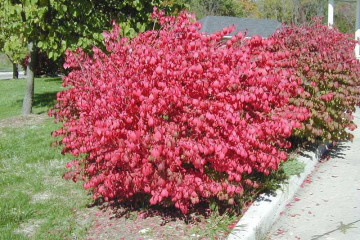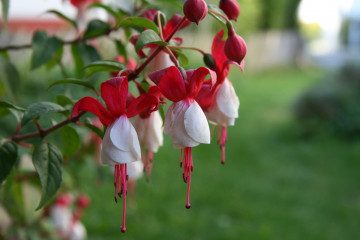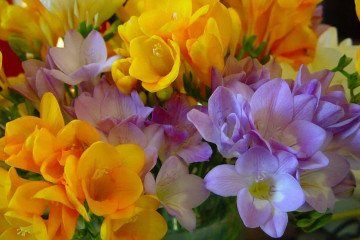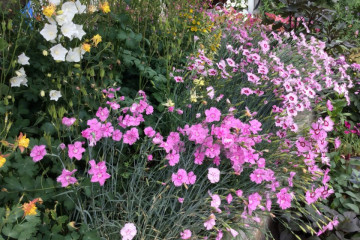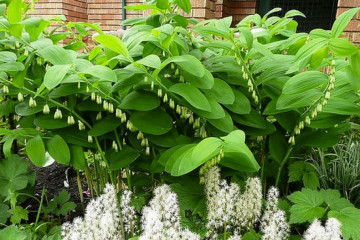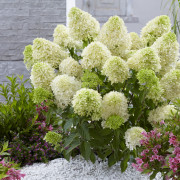Creeping euonymus - planting, care and cultivation in the garden
Content:
- What does a creeping euonymus look like, which family does it belong to?
- Briefly about the history of appearance
- Description of the euonymus plant
- Use in landscape design
- Description of popular varieties of creeping variegated euonymus, their advantages and disadvantages
- Features of care for creeping euonymus in the open field
- Features of care in winter, dormant period
- How euonymus reproduces in the garden
- Pests
The euonymus remains decorative until late autumn. Several hundred species of evergreen and deciduous shrubs of this family are known in the world. Winter-hardy varieties include red euonymus, which grow in the European part of Russia.
What does a creeping euonymus look like, which family does it belong to?
The Euonymus group, or euonymus, includes undersized and tall shrubs with different leaf shapes and colors.
Briefly about the history of appearance
The euonymus family includes more than 200 species. It grows in Asia, Sakhalin, the American continent, and Europe. According to one version, the name of the plant is translated as "alluring beauty", according to the other - "good, glorious."
Description of the euonymus plant
Several main groups can be distinguished:
- evergreen varieties of shrubs with leathery leaves. Such euonymus is grown as an indoor flower. The spherical bush grows up to 50 cm tall;
- creeping euonymus is a ground cover plant with shoots up to 1.5 m long, up to 35 cm high;
- tall euonymus on a trunk, they are formed like trees;
- in the description of winged euonymus, soft, falling down leaves appear.
Shoots are round or tetrahedral, some varieties have cork growths.
Use in landscape design
The shrub is good in single and group plantings. The variegated euonymus creeping is beautiful on the cascades of alpine hills, mountainous terrain. For solitary planting, medium-sized varieties with colored leaves are used.
Description of popular varieties of creeping variegated euonymus, their advantages and disadvantages
Compactus
The Compactus bush reaches 1.5 meters in height, forms a spherical crown with a diameter of up to 2 meters. The crown is compact, thickened, without forming it becomes openwork from the edges. In autumn, the green leaves take on a reddish-purple color. The fruits are red-orange.
Fortune
Creeping euonymus with variegated spots and brushstrokes on the leaves are fast-growing. Euonymus fortunei, originally from China, is hardy, evergreen, white-green. Emerald Gold is a Japanese variety of yellow euonymus, which is able to creep, forming a cover up to 30 cm high.
Others
Chicago grows up to 1.5 meters tall, elliptical leaves turn crimson with the onset of frost.Fireball is valued for its spherical shape, ribbed shoots, dense crown, red-purple autumn color. In Macrophilis, elongated leaves acquire a carmine color, the fruits are bright orange, decorative.
Features of care for creeping euonymus in the open field
For garden euonymus, areas that dry out early in spring are chosen. It takes root well on hills and slopes. Creeping well tolerates partial shade, diffused light.
Watering
Watering is necessary only during dry periods.
Spraying
Sprinkling irrigation is allowed.
Humidity
The shrub does not like excess moisture, but the earthen lump should always remain moist.
Priming
Subtropical plants grow well on loose, humus-rich soils, leafy soil.
Top dressing:
- in the spring, nitrogen fertilizers are applied;
- in the summer the bush needs phosphorus, potassium, calcium;
- in the fall, the soil is enriched with superphosphate, ash, compost.
Features of care in winter, dormant period
Heat-loving evergreen euonymus need home conditions, the care is the same as in the garden. Since December, the pot is transferred to a place where the temperature is from 5 to 15 degrees. The earth is kept moist.
When and how it blooms
Types of flowers
In May-June, the bush is covered with a scattering of small light flowers, collected in inflorescences, they have up to 5 sepals, the same number of petals. The pistil has a lobed ovary. Flowers are:
- white with brittle petals;
- corymbose green with carpal inflorescences;
- brownish with axillary leaves.
Flower shapes:
- spherical;
- membranous accrete;
- straight single row;
- curved outward.
Flowering period
The bushes begin to bloom in May and June, depending on which variety. Deciduous bloom later than evergreen.
Changes in care during flowering
Inflorescences, like chameleons, change color: from white or pale green they turn into scarlet, red-pink, purple, carmine or deep yellow. Orange, light yellow or bright red fruits are formed.
Euonymus at home: care
Pruning
The crown is adjusted with garden shears or pruning shears. The bush can be given any shape required for landscape design. Pruning is carried out in early spring or late autumn.
How euonymus reproduces in the garden
When euonymus reproduces, planting is carried out in early spring.
Germinating seeds
The inoculum is harvested during the cracking of the seed pods. How to plant euonymus:
- the seeds are kept in the refrigerator (winter-hardy varieties in the freezer) for 4 or 6 months;
- before deepening, the seeds are wrapped in a damp cloth for pecking;
- deepen the seed with a sprout by 0.5 cm, create conditions of high humidity and temperature;
- grow seedlings at home for 2 years.
Rooting cuttings
An internode is left on each branch 6 to 10 cm long. After a week in the water and the formation of roots, cuttings are planted in a greenhouse or greenhouse in June-early July. They are transferred to the ground at the end of September.
Air layering
The offspring grow well in spring and autumn. They are moved to a permanent place immediately after the snow melts or at the beginning of September so that they can take root before winter.
Other options
In the garden, dwarf and creeping euonymus are more often propagated by dividing the bush, carefully separating parts with a full rhizome from the mother bush. At the delenka, before planting, the shoots are shortened by 2/3 parts.
Possible problems in growing a creeping spindle tree:
- leaves turn pale;
- with insufficient illumination, excess moisture, the color changes;
- the tips of the leaves dry;
- lack of phosphorus and potassium fertilizers, excess nitrogen, excessive soil moisture;
- the lower leaves fall off.
Possible causes: too dry ground, extreme heat, or sucking pests.
Pests
In the hot season, they attack: aphids, caterpillars, spider mites. Leaves curl, begin to crumble.
Other problems
It is advisable to regularly inspect the spindle tree during care and cultivation. It is prone to powdery mildew.
Euonymus Compactus, Forchuna, Winged are no longer uncommon on the sites. Bushes are planted in remote areas, away from animals and children. Plants add color to a graying autumn landscape.





